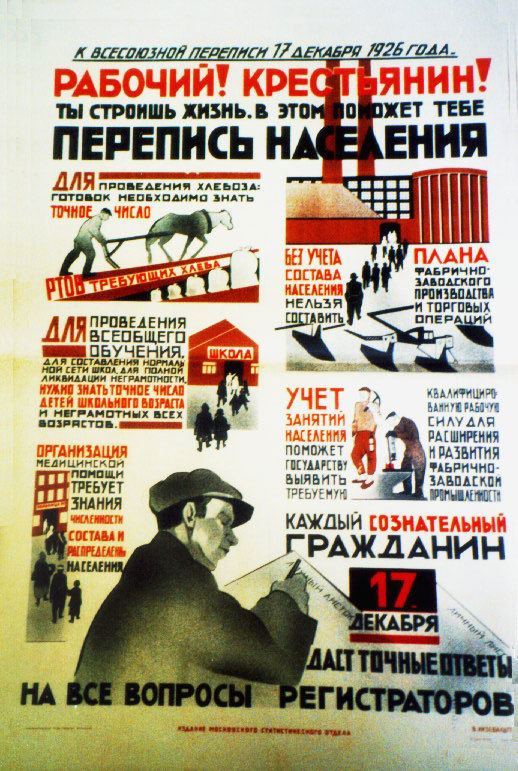 | ||
The First All Union Census of the Soviet Union took place in December 1926. It was an important tool in the state-building of the USSR, provided the government with important ethnographic information, and helped in the transformation from Imperial Russian society to Soviet society. The decisions made by ethnographers in determining the ethnicity (narodnost) of individuals, whether in the Asiatic or European parts of the former Russian Empire, through the drawing up of the "List of Ethnicities of the USSR", and how borders were drawn in mixed areas had a significant influence on Soviet policies. Ethnographers, statisticians, and linguists were drawing up questionnaires and list of ethnicities for the census. However, they also had the more ambitious goal of deliberately transforming their identities according to the principles of Marxism-Leninism. As Anastas Mikoyan put it, the Soviet Union was: "creating and organising new nations".
Contents
Previous censuses
The First All Union Census of the Soviet Union followed two partial censuses carried out by the Bolsheviks following their seizure of power in Russia. The first, the general census of 1920, took place during the Civil War and the Soviet-Polish War. It was thus unable to deal with the Crimea, much of Transcaucasia, Ukraine, Byelorussia, Far Eastern, Siberian, and Central Asian parts of the Soviet Union as well as with its Far Northern parts. Yet it is worth to note that there was only 15,000,000 population increase between 1920 and 1926 constituting in some 131,304,931 people according to the TIME magazine while is still undisclosed in Russian history. The 1923 Census was restricted to cities. Prior to the Russian Revolution, the only Russian Empire Census was done in 1897.
Methodology
By classifying the population in terms of narodnosti (nationalities)—as opposed to tribe or clan—along with policies which gave these nations land, resources, and rights, experts and local elites were encouraged to interfere with the information collecting.
List of ethnicities
This list, called Programmy i posobiya po razrabotke Vsesoyuznoy perepisi naseleniya 1926 goda, vol. 7, Perechen i slovar narodnostey, Moscow 1927, was developed by the Central Statistical Administration of the USSR.
Composition of the USSR
For the Transcaucasian Socialist Federative Soviet Republic, Georgians were considered the Titular Nationality.
